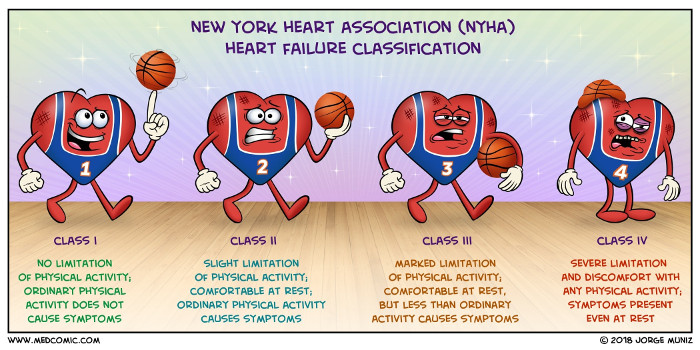There are multiple causes for exertional breathlessness. These are usually cardiac or respiratory, for example:
- heart failure, angina with atypical features
- chronic obstructive pulmonary disease, asthma, pneumonia, pulmonary embolism, lung malignancy
- other systems that effect oxygen delivery also cause breathlessness eg anaemia
Cardiac causes of breathlessness
Heart failure is a clinical syndrome characterised by typical symptoms (eg breathlessness, ankle swelling and fatigue) that may be accompanied by signs (eg elevated jugular venous pressure, pulmonary crackles and peripheral oedema) caused by a structural and/or functional cardiac abnormality, resulting in a reduced cardiac output and/or elevated intracardiac pressures at rest or during stress.
[SOURCE: Ponikowski P et al. 2016 ESC guidelines for the diagnosis and treatment of acute and chronic heart failure. The task force for the diagnosis and treatment of acute and chronic heart failure of the Europen Society of Cardiology (ESC). European Heart Journal 2016;37:2129-2200.]
Demonstration of an underlying cardiac cause is central to the diagnosis of heart failure and crucial for therapeutic reasons, as the underlying pathology may determine which treatment is used.
The terminology used to describe chronic heart failure is based on left ventricular function (measurement of left ventricular ejection fraction LVEF):
| Heart failure reduced ejection fraction (HFrEF) | Heart failure mid-range ejection fraction (HFmrEF) | Heart failure preserved ejection fraction (HFpEF) | |
|---|---|---|---|
| Symptoms/signs | Yes | Yes | Yes |
| LVEF | <40% | 40-49% | ≥50% |
| Additional criteria | None |
|
|
Symptoms are often non-specific and may be particularly difficult to interpret in obese individuals, the elderly and those with chronic lung disease. Typical symptoms include breathlessness, orthopnoea, paroxysmal nocturnal dyspnoea, reduced exercise tolerance, fatigue and ankle swelling. Patients may also become breathless bending forward (bendopia), doing up shoe laces for example, a particulary common symptom with central obesity due to deformation and splinting of the diapragm.
Symptom severity is graded using the New York Heart Association (NYHA) classification (Figure 1):
